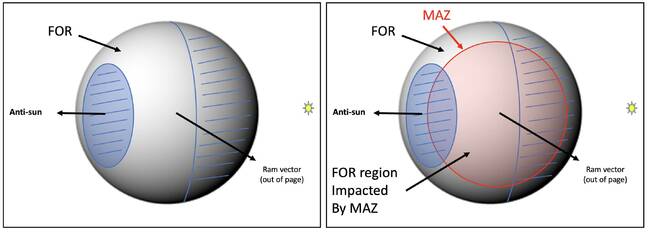This article is more than 1 year old
NASA's meteor avoidance plan for James Webb Space Telescope: Turn it around
When a grain of sand moves fast enough to crack a mirror, it's best to put your back to the wind
After several months of discussions, NASA optics and micrometeoroid experts working on the James Webb Space Telescope have figured out how to reduce micrometeor damage to the $10 billion machine: turn it around.
Webb has suffered 14 measurable micrometeoroid hits to its primary mirror, which is about what NASA has expected, the space agency said. Still, after a serious strike in late May, the Webb team isn't taking any chances.
"The higher-energy impact observed in May was a rare statistical event both in terms of energy, and in hitting a particularly sensitive location on Webb's primary mirror," NASA said. While rare, the team still saw fit to disrupt Webb's schedule by changing its orientation to face away from what the team termed the "micrometeoroid avoidance zone (MAZ)."
That zone, according to the Space Telescope Science Institute (STScI), occupies a cone that sits in the forward-facing side of the telescope's orbital motion direction.

the JWST's Meteor Avoidance Zone, in red. Ram vector indicates direction of orbital travel
Changing Webb's direction as it sails through space at 30km per second (18.6 miles per second) means it won't be able to make observations of objects in the MAZ, but it doesn't mean those objects can't be observed at all, NASA said. Instead, "observations of those objects will be more safely made at a different time in the year when Webb is in a different location in its orbit."
- Spooky Pillars of Creation snap reveals a dark side
- We've seen things you people wouldn't believe. A planet, dense as a marshmallow, that would float on water
- NASA, SpaceX weigh invoking Dragon to take Hubble higher
- The years were worth the wait. JWST gives us an amazing view of Neptune's rings
Special dispensation is available for observations that are time-critical, but such requests "will need to be strongly justified, and may be rejected if the demand for such observations is too high," the STScI said.
Lee Feinberg, Webb's optical telescope element manager at NASA's Goddard Space Flight Center, said that micrometeoroids striking the Webb mirror head on have twice the relative velocity and four times the kinetic energy of a less direct impact. "Avoiding this direction when feasible will help extend the exquisite optical performance for decades," Feinberg said.
The May impact struck with enough force to be beyond what teams on the ground could have tested, NASA said at the time. Micrometeoroids are often smaller than one millimeter in diameter, but because they hit with an average impact velocity of 10kps (6.2 miles a second) – or 36,000kph/22,320mph – they can leave craters visible to the naked eye.
The JWST, with its unprotected central mirror, is exposed to all the hazards of space and the damage that comes with them. That makes its observations far superior to the well-insulated Hubble, but far less resilient.
As such, NASA only plans for the JWST to last five years, though it hopes the mirror will remain intact enough to make it a reliable observatory for at least a decade. Let's hope future fixes are as simple as turning the telescope to face a different direction. ®
